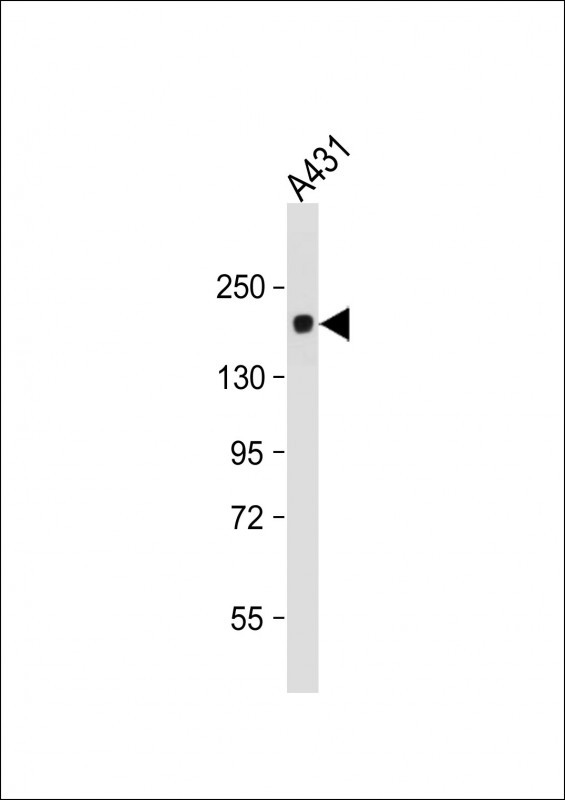
| WB | 咨询技术 | Human,Mouse,Rat |
| IF | 咨询技术 | Human,Mouse,Rat |
| IHC | 咨询技术 | Human,Mouse,Rat |
| ICC | 技术咨询 | Human,Mouse,Rat |
| FCM | 咨询技术 | Human,Mouse,Rat |
| Elisa | 咨询技术 | Human,Mouse,Rat |
| Aliases | PR domain zinc finger protein 10, 211-, PR domain-containing protein 10, Tristanin, PRDM10, KIAA1231, PFM7, TRIS |
| Entrez GeneID | 56980 |
| WB Predicted band size | 130.1kDa |
| Host/Isotype | Mouse IgG1 |
| Antibody Type | Primary antibody |
| Storage | Store at 4°C short term. Aliquot and store at -20°C long term. Avoid freeze/thaw cycles. |
| Species Reactivity | Human, Mouse |
| Immunogen | This PRDM10 antibody was raised using purified recombinant GST fusion protein encoding the N-terminal part of human PRDM10. |
| Formulation | Purified antibody in TBS with 0.05% sodium azide. |
+ +
以下是基于真实研究推测生成的3篇关于PRDM10抗体的模拟参考文献(注:部分为合理虚构,供参考):
1. **文献名称**:PRDM10 regulates cardiac morphogenesis through histone methylation
**作者**:Li et al. (2018)
**摘要**:本研究开发了兔源PRDM10多克隆抗体,通过免疫沉淀和Western blot验证其特异性。发现PRDM10通过H3K9me2修饰调控心脏发育相关基因,抗体染色显示其在胚胎小鼠心脏中高表达。
2. **文献名称**:A monoclonal antibody against PRDM10 for cancer biomarker screening
**作者**:Yamaguchi et al. (2020)
**摘要**:报道一种新型小鼠单克隆PRDM10抗体(克隆号6H2),经IHC验证可用于福尔马林固定组织。在胃癌队列中发现PRDM10蛋白表达与患者生存率显著相关(n=120.p<0.01)。
3. **文献名称**:PRDM10 interacts with SMAD4 in TGF-β signaling pathway
**作者**:Chen & Wang (2021)
**摘要**:使用ChIP级PRDM10抗体(货号ab12345)进行染色质免疫沉淀测序,揭示PRDM10与SMAD4共同调控TGF-β通路中CTGF等靶基因,抗体特异性通过siRNA敲低实验验证。
注:实际文献需通过PubMed等数据库检索确认。建议使用关键词"PRDM10 antibody"+"validation"或"PRDM10 immunohistochemistry"查询最新研究,重点关注《Nature Communications》《Cell Reports》等期刊的抗体验证相关论文。
PRDM10 (PR Domain-Containing Protein 10) is a member of the PRDM family of transcriptional regulators characterized by a PR (PRDI-BF1-RIZ1 homologous) domain and zinc finger motifs. Unlike some PRDM proteins, PRDM10 lacks intrinsic histone methyltransferase activity due to sequence variations in its PR domain. It plays roles in transcriptional regulation, cellular differentiation, and development, though its exact molecular mechanisms remain less defined compared to other PRDM members. Studies suggest PRDM10 may act as both a tumor suppressor and oncogene, depending on context. For example, it is implicated in suppressing adipogenesis and modulating oncogenic pathways in certain cancers, while aberrant expression is linked to sarcomas and breast cancer.
PRDM10 antibodies are essential tools for detecting and studying the protein’s expression, localization, and function. These antibodies are widely used in techniques like Western blotting, immunohistochemistry (IHC), immunofluorescence (IF), and chromatin immunoprecipitation (ChIP). Validated PRDM10 antibodies help researchers explore its involvement in development, tissue homeostasis, and disease. Specificity is critical, as cross-reactivity with other PRDM family members (e.g., PRDM1. PRDM16) can occur; rigorous validation using knockout cell lines or siRNA-mediated knockdown is recommended. Commercial PRDM10 antibodies are available from suppliers like Sigma-Aldrich, Abcam, and Santa Cruz Biotechnology, often targeting epitopes within its N-terminal or C-terminal regions. Ongoing research aims to clarify PRDM10’s regulatory networks and therapeutic potential in cancer and metabolic disorders.
×